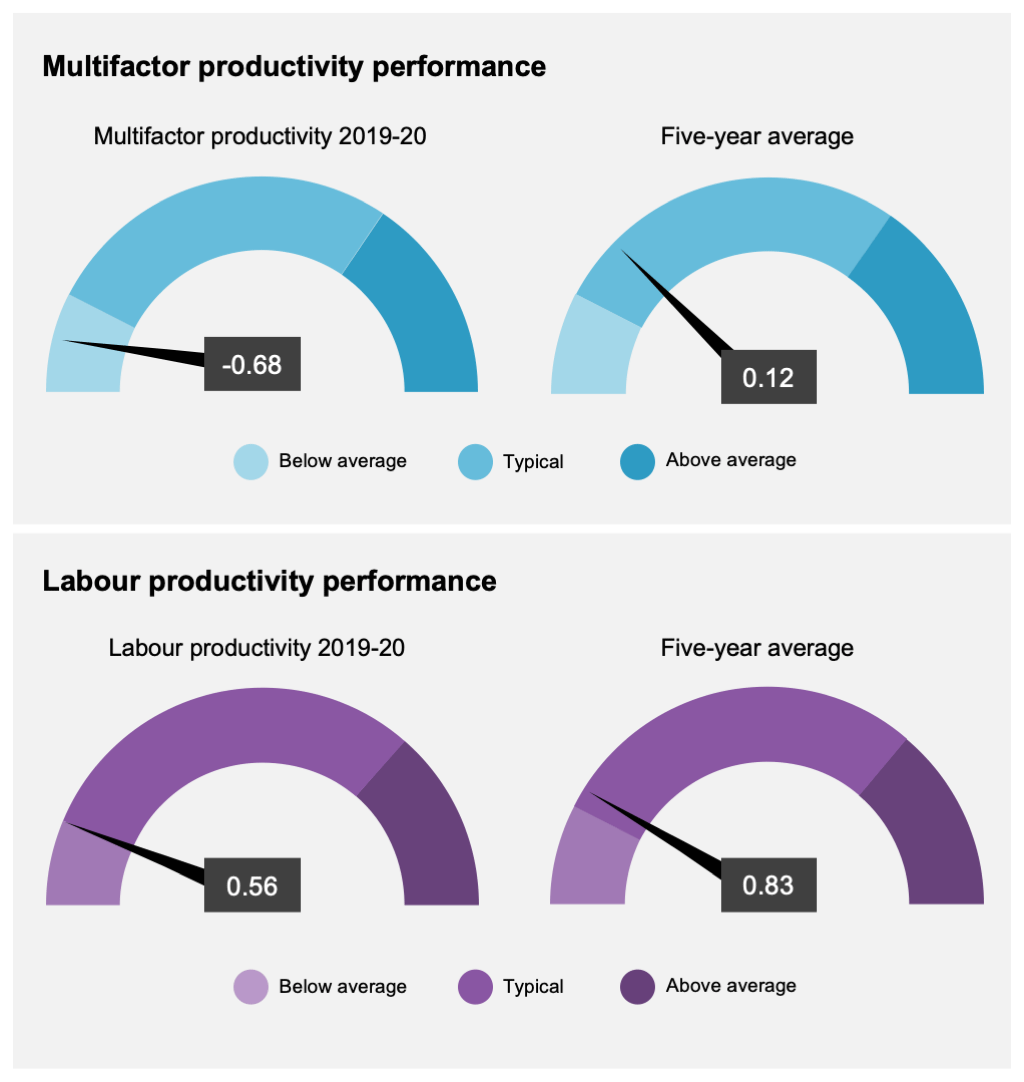Recent developments
PC productivity insights
This productivity insights research was released on 17 June 2021. The 2021 productivity insights unpacks and analyses the latest Australian Bureau of Statistics (ABS) productivity statistics, and details and comments on trends and new developments underlying Australia's recent productivity performance.
Download the research
- PC productivity insights 2021: Recent developments (PDF - 1008 Kb)
- PC productivity insights 2021: Recent developments (Word - 1454 Kb)
The following excel file contains tables of data used to make the charts within this report.
- Productivity at a glance
- Media release
- Contents

Productivity at a glance (text version of above image)
Multifactor productivity performance
Multifactor productivity 2019-20 -0.68%
Five year average +0.12%
Labour productivity performance
Labour productivity 2019-20 0.56%
Five year average 0.83%
Sources: Estimates based on: ABS (2020, Australian System of National Accounts, 2019-20, Cat. no. 5204.0, tables 1, 5, 15, 46 and 58); ABS (2020, Estimates of Industry Multifactor Productivity, 2019-20, Cat. no. 5260.0.55.002, tables 1, 6 and 14); ABS (Labour Force, Australia, Detailed, Quarterly, Cat. no. 6291.0.55.003, Apr 2021, table 11); and ABS (unpublished data).
productivity insights: Recent developments
The impact of the COVID-19 crisis on productivity was unprecedented. The effects varied across industries and are continuing to play out throughout Australia.
A report by the Productivity Commission found that while overall labour productivity rose weakly, multifactor productivity — a measure of how well the economy uses its resources to produce output — fell for the first time in nearly a decade.
The COVID-19 recession was much shorter and sharper than previous recessions. During the initial lockdown, output fell faster than in previous recessions; but by December 2020, employment and output had nearly returned to pre-COVID levels.
While most industries experienced a contraction in both their production and employment, an industry’s overall productivity growth depended on which of the two experienced a greater contraction.
“This explains why productivity rose in some of the hardest hit industries such as arts and recreation — their output fell by less than their employment levels,” Productivity Commission Chair Michael Brennan said.
Some industries boomed. “The strong growth in the output of computer systems and related services was driven by the needs of a workforce adapting to working from home due to COVID-19,” Mr Brennan said. The mining industry — especially oil and gas extraction — also experienced strong growth.
Recent improvements in the unemployment figures towards the end of 2020 reflect the containment of COVID-19 and the removal of most domestic restrictions, combined with the extraordinary levels of government assistance (primarily through the JobKeeper and Cashflow Booster programs).
“Preventing business closures during the pandemic undoubtedly cushioned the downturn and helped smooth recovery. As the recovery proceeds, there will inevitably be some reallocation of labour and capital across firms and industries, which is part and parcel of a dynamic economy,” Chair Michael Brennan said.
“Productivity growth is a key contributor to our long-run prosperity. Our high standard of living is a direct result of gains in productivity over many decades,” Mr Brennan said.
The report is available from www.pc.gov.au
Media requests
Simon Kinsmore – 0455 949 554 / 02 6240 3330 / media@pc.gov.au
- Preliminaries: Cover, Copyright and publication detail, Foreword and Contents
- Productivity insights: recent developments
- Chapter 1 The first recession in 28 years
- Chapter 2 Industry-level productivity performance
- Chapter 3 Structural effects of COVID-19
- Chapter 4 Decade in review: slowest growth in 60 years
- Appendix A Subdivision employment
- Appendix B Calculating the effect of reallocation and within industry growth on aggregate productivity
- Abbreviations
- References
Printed copies
This publication is only available online.
Publications feedback
We value your comments about this publication and encourage you to provide feedback.